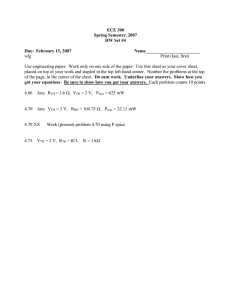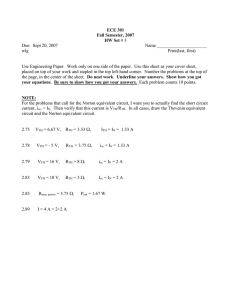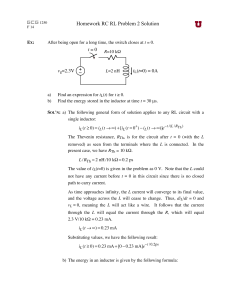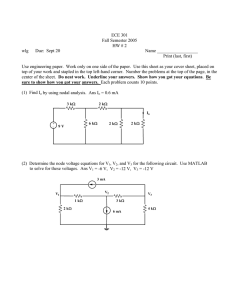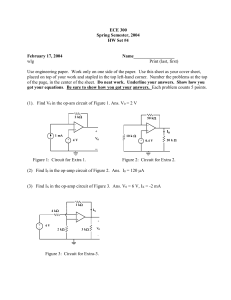Network Theorems (Part I)
advertisement
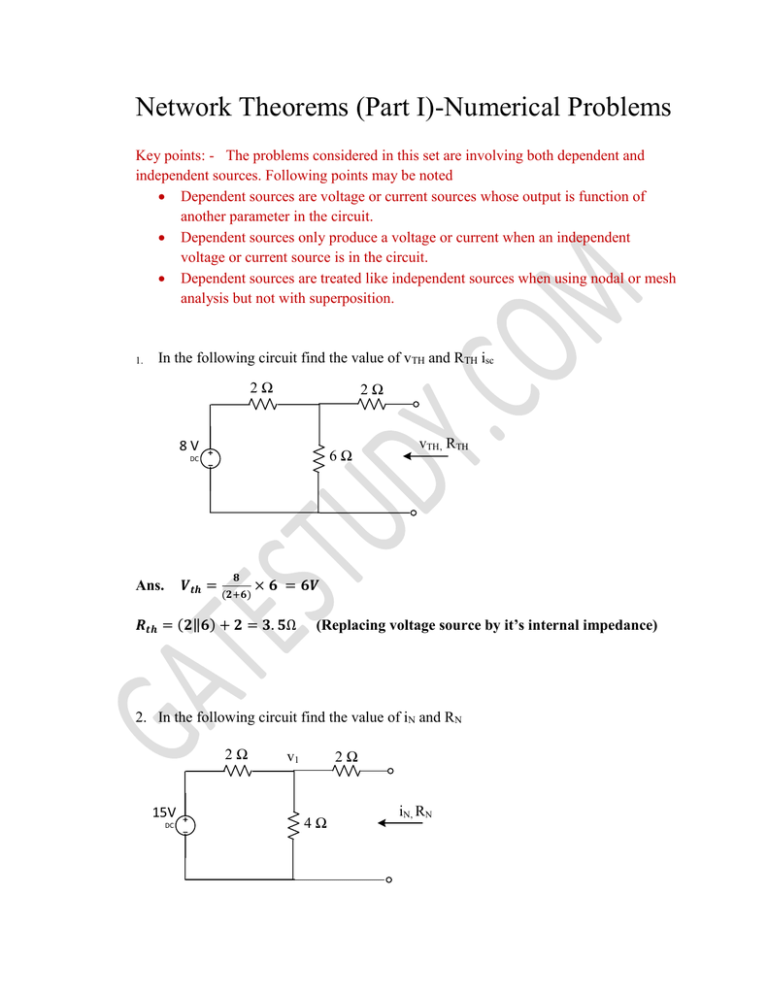
Network Theorems (Part I)-Numerical Problems Key points: - The problems considered in this set are involving both dependent and independent sources. Following points may be noted Dependent sources are voltage or current sources whose output is function of another parameter in the circuit. Dependent sources only produce a voltage or current when an independent voltage or current source is in the circuit. Dependent sources are treated like independent sources when using nodal or mesh analysis but not with superposition. 1. In the following circuit find the value of vTH and RTH isc 2 2 8V 6 DC vTH, RTH 𝟖 𝑽𝒕𝒉 = (𝟐+𝟔) × 𝟔 = 𝟔𝑽 Ans. (Replacing voltage source by it’s internal impedance) 𝑹𝒕𝒉 = (𝟐‖𝟔) + 𝟐 = 𝟑. 𝟓Ω 2. In the following circuit find the value of iN and RN 2 15V DC v1 2 4 iN, RN 𝑹𝑵 = 𝟐‖𝟒 + 𝟐 Ans. = 𝟏𝟎 𝟑 Ω 𝒊𝑵 = short circuit current (𝒊𝒔𝒄 ), By source transformation the equivalent circuit is 2 isc 2 7.5A 𝒊𝒔𝒄 = 𝟕.𝟓×(𝟐‖𝟒) 𝟐+𝟐‖𝟒 = 𝟕.𝟓×𝟒 𝟏𝟎 𝟑( ) 𝟑 4 𝟑𝟎 = 𝟏𝟎 = 𝟑 𝒂𝒎𝒑𝒔 3. In the following circuit find the value of vTH and RTH 2 2A Ans. vTH, RTH 1 3 𝟐×𝟑 Current through 1Ω resistor (using current division) = 𝟑+𝟑 = 𝟏𝒂𝒎𝒑 𝑽𝒕𝒉 = 𝟏 𝒗𝒐𝒍𝒕 𝑹𝒕𝒉 = 𝟏‖𝟓 = 𝟏×𝟓 𝟔 𝟓 = 𝟔Ω (Replacing current source by it’s internal impedance i.e. open circuit) 4. For the following circuit find the value of vTH and RTH 30 25 P 20 5V vTH, RTH DC 5A Ans. To calculate 𝑹𝒕𝒉 , deactivate all independent sources i.e, replace them by their internal impedances. 30 25 RTH 𝑹𝒕𝒉 = 𝟑𝟎 + 𝟐𝟓 = 𝟓𝟓Ω 𝑽𝒕𝒉 = 𝒗𝒐𝒍𝒕𝒂𝒈𝒆 𝒂𝒕 𝒏𝒐𝒅𝒆 𝑷 = 𝟓 × 𝟑𝟎 + 𝟓 = 𝟏𝟓𝟓 𝑽 5. In the following circuit find its Thevenin and Norton equivalent 2 4V Ans. DC 𝑽𝒕𝒉 = 𝟒 + 𝟐 × 𝟐 = 𝟖𝑽 3 2A 𝑹𝒕𝒉 = 𝟐 + 𝟑 = 𝟓Ω 3 2 2A DC 2 Isc 3 RTH Short circuit current is due to voltage source (4 Volts) and current source(2 Amp.) Using superposition 𝟒 Short circuit current due to voltage source = 𝟓 𝟐×𝟐 𝟒 Short circuit current due to current source = 𝟐+𝟑 = 𝟓 𝟒 𝟒 𝟖 𝑰𝒔𝒄 = 𝟓 + 𝟓 = 𝟓 𝒂𝒎𝒑 Thevenin’s and Norton’s equivalents are shown below: Rth VTH Isc DC Thevenin s equivalent Rth Norton s equivalent 6. For the following circuit find the value of vTH and RTH i1 6 3i1 + vTH, RTH 4 - Ans. Circuit does not have any independent source, So, 𝑽𝒕𝒉 = 𝟎. For finding 𝑹𝒕𝒉 connect test voltage source Vtest at terminals XY supplying 1A 𝒊𝟏 = −𝟏𝑨 6 3i1 P + i1 4 - DC 1A Writing node equation at node P 𝑽𝒕𝒆𝒔𝒕 𝟒 + 𝑽𝒕𝒆𝒔𝒕 −𝟑𝒊𝒊 𝟔 + 𝒊𝟏 = 𝟎 𝟓 𝑽𝒕𝒆𝒔𝒕 = −𝟔 𝒊𝟏 = 𝟔 𝟔 𝑽𝒕𝒆𝒔𝒕 = 𝟓 𝑹𝒕𝒉 = 𝑽𝒕𝒆𝒔𝒕 𝟏 𝟔 = 𝟓 = 𝟏. 𝟐Ω Vtest 7. In the circuit shown in following figure find the value vTH and RTH -+ 4V + 0.1v1 vTH, RTH 5 v1 Ans. By source transformation - + 5v1 5 -+ 4V X v1 Y 𝑽𝒕𝒉 = 𝒗𝟏 𝟎. 𝟓 𝒗𝟏 + 𝟒 = 𝒗𝟏 𝟎. 𝟓 𝒗𝟏 − 𝒗𝟏 = −𝟒 𝟒 𝒗𝟏 = 𝟎.𝟓 = 𝟖 𝑽𝒕𝒉 = 𝟖 𝒗𝒐𝒍𝒕𝒔 𝑹𝒕𝒉 = 𝑽𝒕𝒉 𝑰𝑺𝑪 , 𝒊𝒔𝒄 is short circuit current. By putting short across 𝑿𝒀, 𝒗𝟏 = 𝟎, so 𝟒 𝟎 , 𝒊𝒔𝒄 = 𝟓 𝒔𝒐 𝑹𝒕𝒉 = 𝑽𝒕𝒉 𝒊𝒔𝒄 = 𝟖 𝟒⁄ 𝟓 = 𝟏𝟎Ω dependent voltage source 𝟎. 𝟓 𝒗𝟏 = 8. In the following circuit find the effective resistance faced by the voltage source 4 i vS DC 𝒊= Ans. i/4 𝑽𝑺 𝟒 𝒊 +𝟒 𝟒𝒊 = 𝑽𝑺 + 𝒊 𝟑𝒊 = 𝑽𝑺 𝒊= 𝑽𝑺 𝟑 The effective resistance faced by the voltage source is 3Ω 9. Find the value of R (in ohms) for maximum power transfer in the network shown in the figure. 4 5 20 3A R 25V Ans. For maximum power transfer 𝑹𝑳 = 𝑹𝑺 (resistance looking into the network) Replacing independent sources by their internal impedances. 5 4 20 R 𝑹𝑺 = 𝟓‖𝟐𝟎 + 𝟒 =𝟒+𝟒 = 𝟖Ω 𝑹 = 𝟖Ω 10. Find the Thevenin equivalent impedance ZTh between the nodes P and Q in the following circuit 1F 1H P 1 1 DC 1A Q 10V Ans. For finding 𝒁𝒕𝒉 deactivate all the active sources 1/S S P 1 1 Q 1A 𝒁𝒕𝒉 (Between P & Q nodes) 𝟏 = (𝑺 + 𝟏) ‖(𝟏 + 𝑺) = 𝟏Ω 11. Find the value of RL such that the power transferred to RL is maximum. 10 10 10 DC RL 1A DC For maximum power transfer 𝑹𝑳 = 𝑹𝒕𝒉 Ans. 10 10 10 1A Rth 𝑹𝒕𝒉 = 𝟏𝟎‖𝟏𝟎 + 𝟏𝟎 = 𝟓 + 𝟏𝟎 = 𝟏𝟓Ω 𝑹𝑳 = 𝟏𝟓Ω 12. A source vs(t)=Vcos100 πt has an internal impedance of (4+j3)Ω. If an purely resistive load connected to this source has to extract the maximum power out of the source, find it’s value Ans. For pure resistive load RL to extract the maximum power 𝑹𝑳 = √𝑹𝟐𝑺 + 𝑿𝟐𝑺 = √𝟒𝟐 + 𝟑𝟐 = 𝟓Ω

